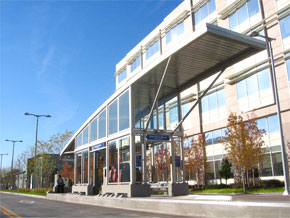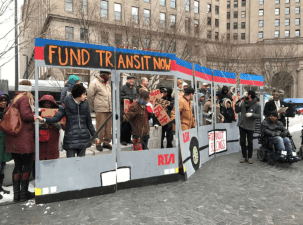Rave Review for Cleveland’s BRT Debut
 Cleveland bus riders at one of the Health Line’s new stations.
Cleveland bus riders at one of the Health Line’s new stations.Cleveland’s first venture into Bus Rapid Transit — a 10-mile route called the Health Line — was turning heads before it fully launched, attracting planners from other cities looking to boost transit ridership. Now that the ribbons have been cut, the Plain Dealer’s Steven Litt hails the finished product:
The core section of the line, from Public Square to University Circle,
has center median stations on raised platforms designed to enable
riders to step directly onto buses, as if they were rail cars. An
innovative precision docking system makes it easy to align the buses
with precise spots on the platforms, so riders know where to queue.The 34 stations along the line are smartly tailored gems. They have
a light, transparent feel that makes them look both elegant and safe.
They complement the architecture of nearby buildings, rather than
obscure views.Less noticeable are the ingenious ways in which landscape
architects from Sasaki Associates in Watertown, Mass., redesigned the
avenue from building face to building face to include 5-foot-wide
bicycle paths and tapering islands with flower beds at the bus
stations.
Intended to spur economic development along the city’s historic but struggling main drag, Euclid Avenue, the Health Line figures to get even more attention from other cities if the Obama administration commits to increased federal investment in transit:
Financed primarily by the state of Ohio and the federal government,
the project shows how smart investments in mass transit and public
space can help struggling cities turn themselves around.The project also is a reminder — after the collapse of the I-35
bridge in Minneapolis and the catastrophic failure of levees in New
Orleans after Hurricane Katrina — that America still has the ability to
tackle high-quality, large-scale infrastructure projects with style.That’s important at a moment in which the country has elected a new
president who wants to invest heavily in urban infrastructure to create
jobs, jump-start a sputtering economy and revitalize cities.Just two weeks after the ribbon-cutting, the Euclid Corridor
project is becoming a national model. Joseph Calabrese, director of the
Greater Cleveland Regional Transit Authority, which masterminded and
built the bus line, said the agency has recently entertained large
civic delegations from San Antonio and Nashville, Tenn.
Photo: Steven Litt/Plain Dealer

